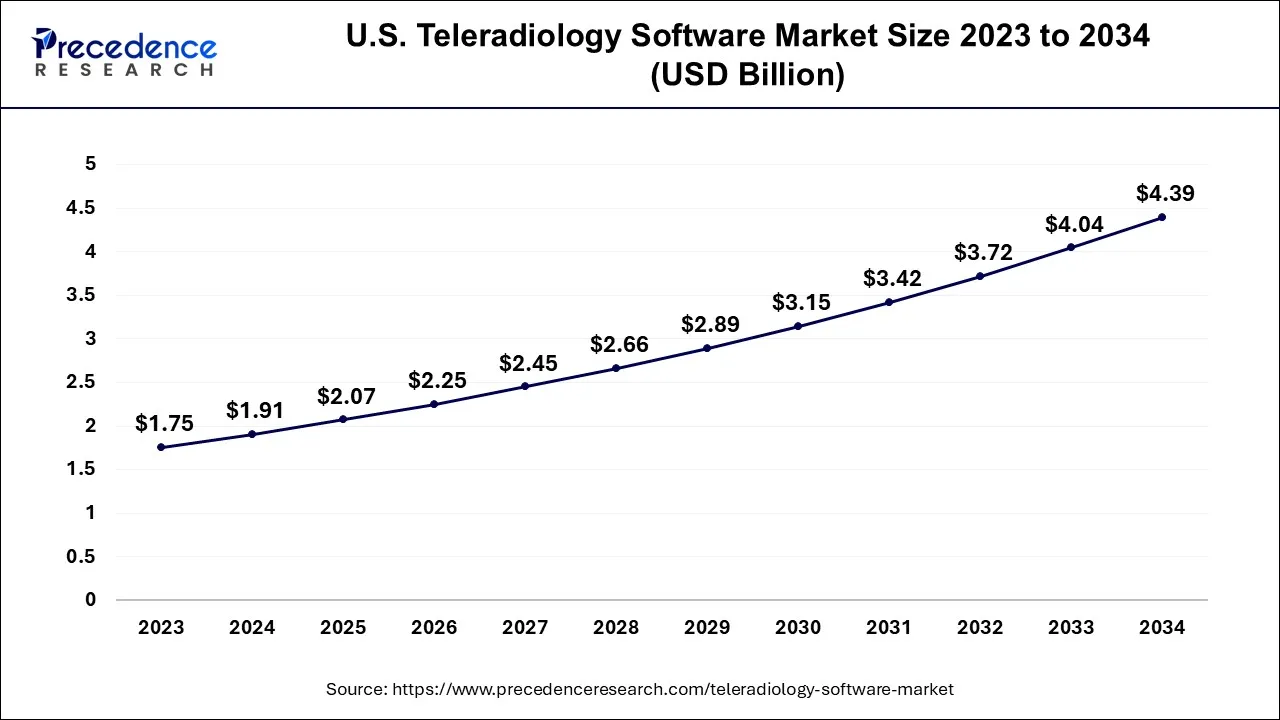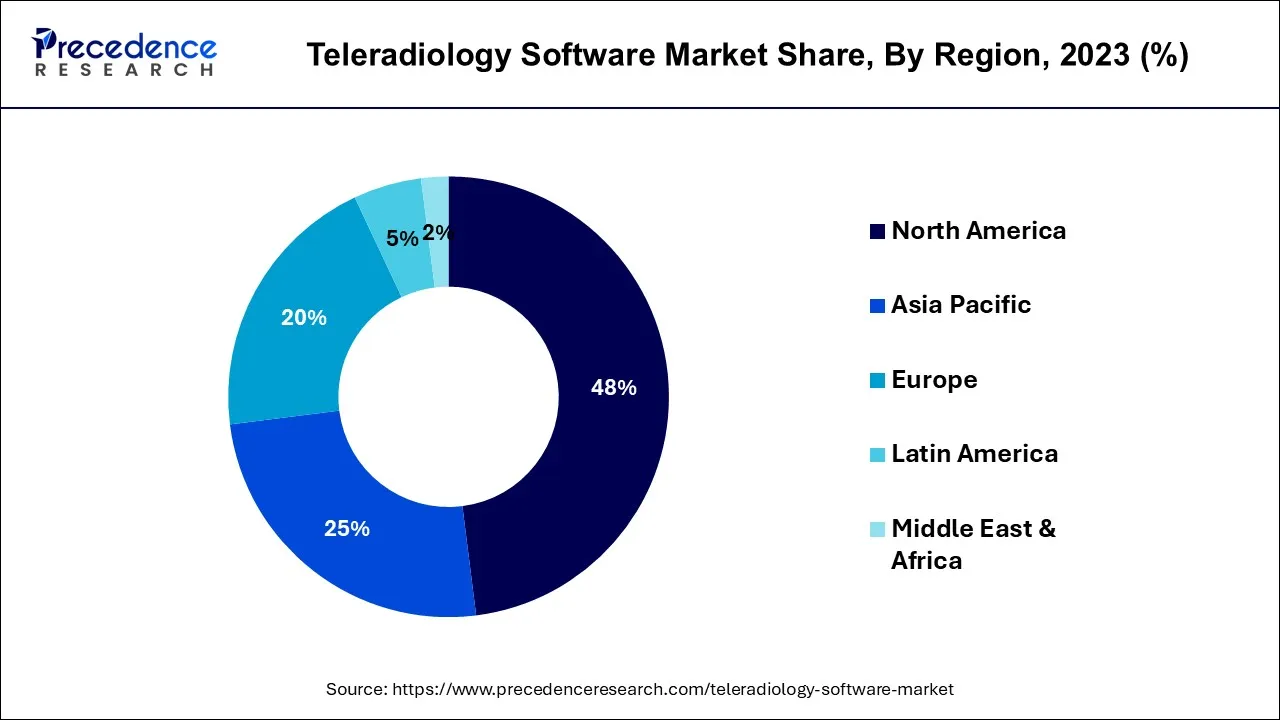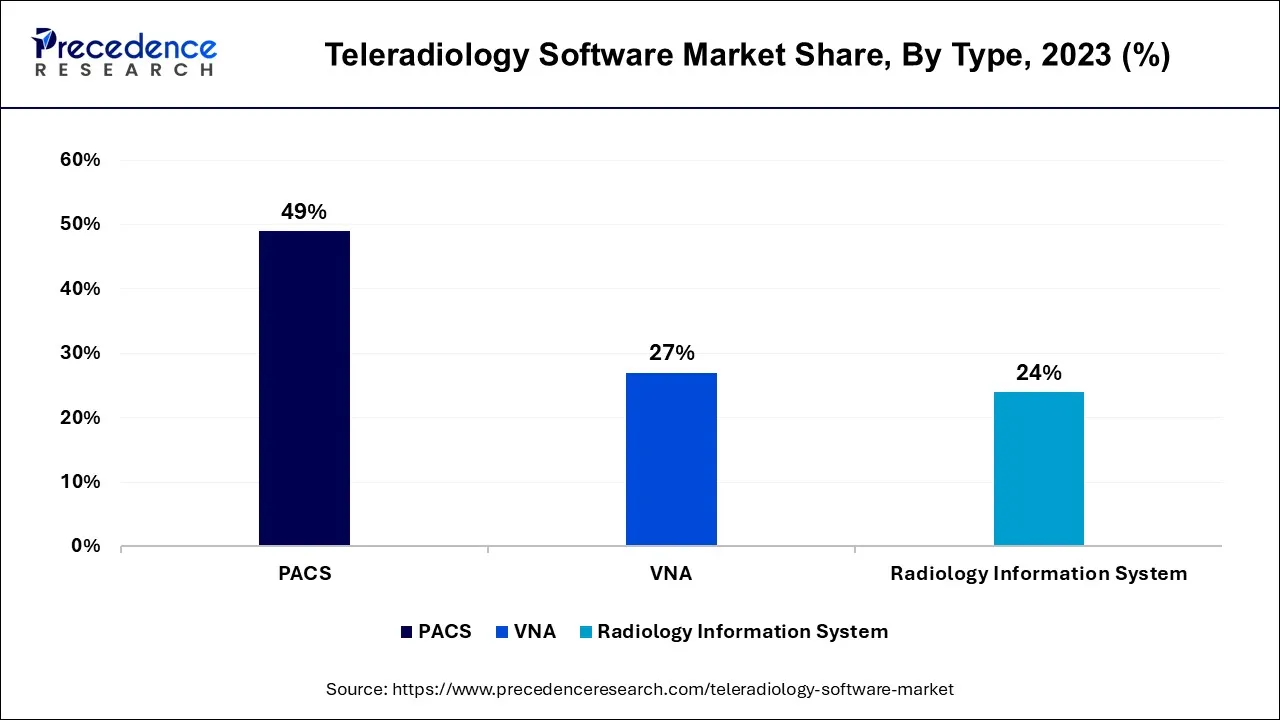January 2025
The global teleradiology software market size accounted for USD 5.65 billion in 2024, grew to USD 6.13 billion in 2025, and is projected to surpass around USD 12.78 billion by 2034, representing a healthy CAGR of 8.5% between 2024 and 2034. The North America teleradiology software market size is calculated at USD 2.71 billion in 2024 and is expected to grow at the fastest CAGR of 8.65% during the forecast year.
The global teleradiology software market size is expected to be valued at USD 5.65 billion in 2024 and is anticipated to reach around USD 12.78 billion by 2034, expanding at a CAGR of 8.5% over the forecast period from 2024 to 2034.

The U.S. teleradiology software market size is calculated at USD 1.91 billion in 2024 and is projected to be worth around USD 4.39 billion by 2034, poised to grow at a CAGR of 8.7% from 2024 to 2034.

North America has held the largest revenue share 48% in 2023. In North America, the teleradiology software market is witnessing robust growth driven by the region's advanced healthcare infrastructure and a growing preference for remote healthcare solutions. The adoption of teleradiology software in the United States and Canada has been accelerated by the need for efficient image sharing, particularly in rural and underserved areas. Furthermore, there is a rising trend in integrating artificial intelligence algorithms within teleradiology software to enhance diagnostic accuracy and streamline radiologists' workflows.

Asia Pacific is estimated to observe the fastest expansion. In Asia Pacific, teleradiology software adoption is on the rise, primarily due to the increasing demand for healthcare services in densely populated countries like India and China. The COVID-19 pandemic further underscored the significance of teleradiology in this region, prompting healthcare providers to invest in telehealth technologies. Additionally, collaborations with local healthcare startups and the development of cloud-based teleradiology solutions are trends contributing to the market's growth, as healthcare facilities strive to enhance patient care and accessibility to diagnostic services.
In Europe, the teleradiology software market is characterized by its commitment to healthcare innovation and accessibility. European countries have been at the forefront of implementing telehealth solutions, including teleradiology, to bridge healthcare gaps and improve patient outcomes. The region's emphasis on data security and privacy compliance has driven the development of secure and advanced teleradiology platforms. Collaborations between healthcare institutions and technology providers continue to drive progress in the European teleradiology landscape.
The teleradiology software market refers to the technology-driven healthcare subsector focused on remotely transmitting radiological images, such as X-rays, MRIs, and CT scans, for interpretation and diagnosis. This market thrives on the convergence of medical imaging technology and digital communication systems, enabling healthcare professionals to access and analyze medical images from remote locations. Rapid advancements in telecommunications, medical imaging, and data security have propelled the growth of this market, fostered efficient healthcare delivery, and improved diagnostic accuracy.
Teleradiology software enables healthcare providers to streamline their radiology workflows and facilitates real-time collaboration among specialists, allowing for quicker diagnoses and treatment decisions. The market's dynamic nature is characterized by continuous advancements in AI-driven image analysis, enhanced security measures, and increasing demand for telehealth services, making it a pivotal component of modern healthcare infrastructure.
Teleradiology software is a crucial element of modern healthcare, providing efficient remote image interpretation and enhancing collaboration among medical professionals. Its growth is driven by several factors, including the increasing demand for timely radiology services, the expansion of telehealth, and advancements in artificial intelligence for image analysis. Additionally, the COVID-19 pandemic accelerated its adoption as a tool for remote diagnosis and treatment planning.
Despite its growth prospects, the teleradiology software market faces challenges such as data security and privacy concerns, regulatory complexities across regions, and potential limitations in rural areas with limited internet connectivity. However, it presents substantial business opportunities for software developers, healthcare institutions, and radiologists, as the demand for reliable, fast, and accessible radiology services continues to rise.
Collaboration with AI developers to improve image analysis accuracy and exploring emerging markets with underserved healthcare infrastructure are among the avenues for growth in this dynamic industry. The teleradiology software market is projected to play an increasingly pivotal role in modern healthcare, ensuring efficient diagnosis and treatment, especially in remote or underserved areas.
| Report Coverage | Details |
| Growth Rate from 2024 to 2034 | CAGR of 8.5% |
| Market Size in 2024 | USD 5.65 Billion |
| Market Size by 2034 | USD 12.78 Billion |
| Largest Market | North America |
| Base Year | 2023 |
| Forecast Period | 2024 to 2034 |
| Segments Covered | By Type, By Deployment, By End Use |
| Regions Covered | North America, Europe, Asia-Pacific, Latin America, and Middle East & Africa |
Rapid technological advancements and integration of telehealth
Rapid technological advancements have revolutionized the field of teleradiology. The incorporation of artificial intelligence (AI) and machine learning into teleradiology software has significantly enhanced diagnostic capabilities. AI-powered algorithms can assist radiologists in detecting anomalies, improving diagnostic accuracy, and streamlining workflow efficiency. This level of automation and intelligence has made teleradiology a vital component in modern healthcare, enabling faster and more accurate diagnoses, which is especially crucial in emergency cases.
Moreover, the integration of telehealth services has reshaped the healthcare landscape. Telehealth has become an integral part of healthcare delivery, allowing patients and healthcare providers to connect remotely for consultations and medical image sharing. Teleradiology software plays a pivotal role in this ecosystem by facilitating the secure transmission of medical images, enabling real-time consultations, and ensuring timely diagnoses. The convenience and accessibility offered by teleradiology, especially in remote or underserved areas, have led to a substantial increase in its demand. The teleradiology software market's growth is intricately tied to its ability to harness technological advancements and seamlessly integrate with telehealth services. This synergy not only enhances healthcare delivery but also underscores the increasing reliance on teleradiology as an indispensable tool in the healthcare industry.
Regulatory compliance and cost of implementation
Teleradiology software operates within a highly regulated healthcare environment, where patient privacy and data security are paramount. Regulations like the health insurance portability and Accountability Act (HIPAA) in the United States and similar laws globally impose strict requirements on the handling of medical data. Ensuring compliance with these complex and evolving regulations can be a daunting task for software providers. It often requires substantial investments in legal counsel, data encryption, and security measures. Non-compliance can lead to severe penalties and reputational damage, making healthcare institutions cautious when adopting new teleradiology solutions.
Implementing teleradiology software involves various expenses, including the acquisition of software licenses, hardware infrastructure, training of radiologists and healthcare staff, and ongoing maintenance and support. For smaller healthcare facilities or those in resource-constrained settings, the upfront and operational costs can be prohibitive. This financial burden can deter many potential users from embracing teleradiology solutions, limiting their accessibility and depriving patients of improved diagnostic services. It's crucial for software providers to offer scalable pricing models and cost-effective solutions to make teleradiology more accessible to a broader range of healthcare institutions.
Addressing these restraints necessitates a collaborative effort involving software developers, healthcare institutions, and regulatory bodies. Streamlining compliance processes and offering flexible, affordable implementation options can help mitigate these challenges and encourage wider adoption of teleradiology software, ultimately benefiting patient care and healthcare systems globally.
AI integration and cloud-based solutions
The integration of Artificial Intelligence (AI) and the adoption of cloud-based solutions have been instrumental in driving the demand for teleradiology software. AI algorithms are revolutionizing radiology by enhancing the accuracy and efficiency of image analysis. With AI, teleradiology software can automatically identify and highlight abnormalities, speeding up the diagnostic process. This not only saves valuable time but also improves the overall accuracy of diagnoses, ultimately benefiting patient care.
Cloud-based solutions have provided teleradiology with unprecedented flexibility and scalability. Radiologists can access patient images and data from anywhere with an internet connection, making it easier to provide timely consultations and collaborate with specialists globally. Moreover, cloud storage ensures secure data management, addressing concerns about patient privacy and data security. It also eliminates the need for large on-premises servers, reducing infrastructure costs for healthcare providers. As healthcare systems increasingly recognize the value of these advancements, the demand for teleradiology software with AI integration and cloud-based capabilities continues to surge, contributing to the market's substantial growth.
According to the type, the PACS software segment held 48% revenue share in 2023. PACS (Picture Archiving and Communication System) software is a key component of the teleradiology software market. PACS enables the storage, retrieval, and distribution of medical images, enhancing the efficiency of radiology workflows. The trend in PACS software is shifting toward more user-friendly interfaces, advanced visualization tools, and integration with AI algorithms for image analysis, improving radiologists' diagnostic capabilities.

The Vendor Neutral Archive segment is anticipated to expand at a significant CAGR of 10.2% during the projected period. Vendor Neutral Archive (VNA) is another critical element of the teleradiology software market. VNAs allow healthcare organizations to store medical images and related data in a standardized format, ensuring interoperability across different systems. In the market, the trend for VNAs is evolving toward greater scalability and cloud-based solutions, enabling healthcare providers to manage and share large volumes of medical data securely and cost-effectively. These trends reflect the industry's continuous drive for more efficient and innovative solutions in teleradiology software.
Based on the deployment, web-based segment is anticipated to hold the largest market share of 53% in 2023. Web-based teleradiology software operates through internet browsers, allowing users to access and utilize the software from any device with internet connectivity. This deployment method offers flexibility and convenience, particularly for smaller healthcare facilities or individual practitioners. A notable trend in web-based teleradiology software is the focus on user-friendly interfaces and cross-platform compatibility, ensuring accessibility across various devices and operating systems. Moreover, web-based solutions often incorporate AI-driven features for enhanced image analysis and diagnostic accuracy, which is becoming increasingly crucial in the field.
On the other hand, the cloud-based solutions segment is projected to grow at the fastest rate over the projected period. Cloud-based teleradiology software relies on cloud infrastructure to store, manage, and transmit medical images and data securely. This deployment method offers scalability, cost-efficiency, and improved data management, making it a popular choice for healthcare institutions of all sizes. A significant trend in cloud-based teleradiology software is the integration of advanced security protocols and encryption techniques to safeguard patient data and maintain compliance with healthcare regulations. Additionally, the ability to access images and reports remotely has become essential, further driving the adoption of cloud-based solutions, especially in the post-pandemic era where remote work and telemedicine are more prevalent.
In 2023, the hospitals segment had the highest market share of 52% on the basis of the end user. In the teleradiology software market, hospitals and clinics are two prominent end-user segments, each with distinct trends. Hospitals, as major healthcare providers, have increasingly adopted teleradiology software to streamline their diagnostic processes and provide faster patient care. They are investing in integrated platforms that offer real-time image sharing, AI-assisted diagnostics, and secure data storage.
The clinics segment is anticipated to expand at the fastest rate over the projected period. Clinics, on the other hand, often prioritize cost-effective solutions that cater to smaller patient volumes. As a result, they are inclined towards cloud-based teleradiology software, which offers scalability and flexibility without the need for substantial infrastructure investments. Both hospital and clinic segments are witnessing a surge in AI integration, enabling more precise diagnoses and enhancing overall healthcare efficiency. The trends in these segments reflect the growing importance of teleradiology software in modern healthcare, catering to institutions of varying sizes and needs.
Segments Covered in the Report
By Type
By Deployment
By End User
By Geography
For inquiries regarding discounts, bulk purchases, or customization requests, please contact us at sales@precedenceresearch.com
No cookie-cutter, only authentic analysis – take the 1st step to become a Precedence Research client
January 2025
December 2024
January 2025
December 2024